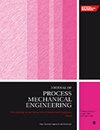活化能和热辐射对存在诱导磁场的波浪形气缸上的混合纳米流体(发动机油+镍锌铁氧体+锰锌铁氧体)流动的影响
IF 2.2
4区 工程技术
Q2 ENGINEERING, MECHANICAL
Proceedings of the Institution of Mechanical Engineers, Part E: Journal of Process Mechanical Engineering
Pub Date : 2024-08-22
DOI:10.1177/09544089241274988
引用次数: 0
摘要
与光滑圆柱体相比,波浪形圆柱体增加了流动的复杂性。分析这种流动有助于研究人员理解边界层行为、阻力和热传导模式等现象,以及现实世界中表面不平整的情况。例如,这些知识可用于理解管道或船体等水下结构周围的流动。本研究探讨了活化能对流经受诱导磁场作用的波浪形圆柱体的辐射混合纳米流体流动的新影响。我们使用含有镍锌铁氧体和锰锌铁氧体纳米颗粒混合物的机油作为基础流体,这种独特的材料组合是以前未曾探索过的。我们将问题方程转化为一系列常微分方程,并使用 bvp4c 求解器巧妙地解决了这些方程。我们使用条形图讨论了相关的物理特性,包括努塞尔特数。显示了鞍状停滞点和节点停滞点情况下的结果。结果表明,摩擦因数随镍锌铁氧体体积分数的增加而上升,随磁性参数的增加而下降;这是研究得出的主要结论。当磁性参数在 0.05 至 0.3 之间时,结点停滞点的摩擦因数以 0.6803 的速度缩小,鞍状停滞点的摩擦因数以 0.73692 的速度缩小。当活化能参数介于 0 和 2 之间时,舍伍德数降低了 0.0046(节点停滞点)和 0.00512(鞍型停滞点)。研究还发现,随着热辐射的增加,流体温度也会升高。这些发现对设计微流体设备、优化磁场存在时的热交换器性能,以及利用波浪形表面和受控热辐射管理微型电子设备中的热耗散具有重要意义。本文章由计算机程序翻译,如有差异,请以英文原文为准。
Impact of activation energy and thermal radiation on hybrid nanofluid (engine oil + nickel zinc ferrite + manganese zinc ferrite) flow over a wavy cylinder in the presence of induced magnetic field
Wavy cylinders add more complexity to the flow than smooth cylinders. Analyzing this flow helps researchers understand phenomena like boundary layer behavior, drag forces, and heat transfer patterns in real-world scenarios with uneven surfaces. For instance, this knowledge can be applied to understanding flow around underwater structures like pipelines or ship hulls. This study investigates the novel influence of activation energy on radiative hybrid nanofluid flow past a wavy cylinder subjected to an induced magnetic field. We use engine oil containing a mixture of nickel zinc ferrite and manganese zinc ferrite nanoparticles as the base fluid, providing a unique combination of materials not previously explored in this context. We have transformed the problem's equations into a collection of ordinary differential equations and skillfully resolved them using the bvp4c solver. Using bar graphs, the relevant physical characteristics, including the Nusselt number, are discussed. The outcomes for the saddle stagnation-point and nodal stagnation-point scenarios are displayed. Results show that friction factor rises with increasing volume fraction of nickel zinc ferrite and declines with increasing magnetic parameter; these are the main conclusions drawn from the study. The friction factor shrinks at a rate of 0.6803 for nodal stagnation points and 0.73692 for saddle stagnation points when the magnetic parameter is between 0.05 and 0.3. The Sherwood number lowers by 0.0046 (in the case of a nodal stagnation point) and 0.00512 (in the case of a saddle stagnation point) when the activation energy parameter is between 0 and 2. It is also found that as thermal radiation increases, the fluid temperature rises. The findings have implications for designing microfluidic devices, optimizing heat exchanger performance in the presence of magnetic fields, and managing thermal dissipation in miniaturized electronics using wavy surfaces and controlled thermal radiation.
求助全文
通过发布文献求助,成功后即可免费获取论文全文。
去求助
来源期刊
CiteScore
3.80
自引率
16.70%
发文量
370
审稿时长
6 months
期刊介绍:
The Journal of Process Mechanical Engineering publishes high-quality, peer-reviewed papers covering a broad area of mechanical engineering activities associated with the design and operation of process equipment.

 求助内容:
求助内容: 应助结果提醒方式:
应助结果提醒方式:


